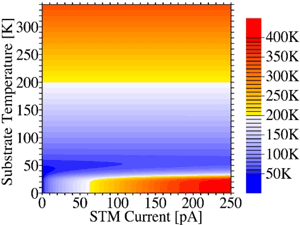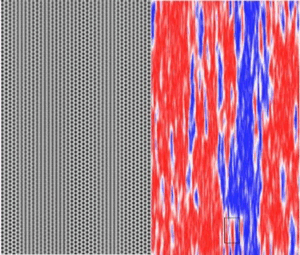
HOME / Departments / Physics / Mathematical Physics
Mathematical Physics
-
- NARIKIYO Osamu, Associate Professor
- Our group studies mathematical aspects of quantum systems with infinitely many degrees of freedom. Current research topics are as follows:
- Gauge theories without ghosts
- Long-range force or infrared divergence in QED
- Emergence of classical degrees of freedom
- Categorical quantum field theory in curved space-time
The vibration of the dimer on Si(001) surface

We describe this system by the Hamiltonian which has the electron-vibration coupling term as the key ingredient. In order to characterize the transition rates induced by STM current between vibrational states, we have introduced the effective temperature of the vibration which differs from the temperature of the substrate. The behavior of the effective temperature depends on the substrate temperature and STM current in highly nonlinear manner and qualitatively changes around 50K of the substrate temperature. At lower temperatures, the effective temperature strongly deviates from the substrate temperature and reaches a few hundred Kelvin for the typical values of STM current. At higher substrate temperatures, the effective temperature reduces to the substrate temperature. On the basis of these behaviors of the effective temperature, we solve the puzzle of the symmetric-asymmetric crossover in dimer images of STM observation in the ordered state of c(4 x 2). [ Kawai and Narikiyo, JPSJ 73 (2004) 417 ]
Critical slowing down on Ge(001) surface

The structural fluctuation of the orientational arrangement of buckled dimers on the Ge(001) surface near the transition temperature of the order-disorder phase transition is investigated by time-resolving dynamical Monte Carlo simulations. STM images averaged in a finite period are derived from the simulation. The coexistence of the c(4 x 2) and the apparent (2 x 1) domains in the STM images observed by experiments is reproduced in the simulated STM images. The coexistence on the Ge(001) surface is attributed to the critical slowing down near the transition temperature. [ Kawai, Narikiyo et al. Surface Science, 600 (2006) 1758 ]
Hall effect in the normal state of high-Tc superconductors
The understanding of the anomalous behavior of the Hall coefficient in the normal state of high-Tc superconductors is a long-standing problem in the study of strongly correlated electron system. First I clarify why the standard theory, the Fermi-liquid theory, does not work in this case. Next I propose an alternative way, the spectral function method, to explain the anomalous behavior. [ Narikiyo, arXiv:1301.5996 ]
Ward identities for thermal transport phenomena
Our understanding of the thermal transport phenomena is very poor compared with that of the electric transport. The difficulty arises from the complex structure of the vertex function of the heat current in the presence of many-body interaction. I succeed in unraveling the structure and establish the conservation law, the Ward identity for the electron system. Then I extend the Ward identity to the case of collective transport via fluctuation modes of superconductivity and density waves. [ Narikiyo, Europhysics Letters, 107 (2014) 17003 ]